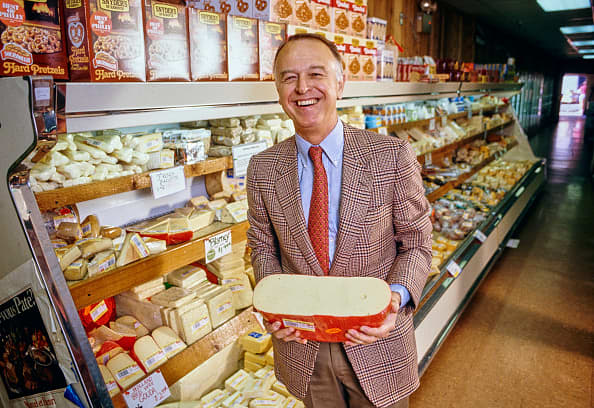
Sixty years ago, Joe Coulombe was a young entrepreneur running a failing chain of convenience stores called Pronto Markets.
Today, he’s known as “Trader Joe,” the founder of a national grocery store empire. The chain has more than 530 locations across the U.S., with 10,000 employees and an estimated 2020 revenue of $16.5 billion, according to Supermarket News and U.K. research firm IGD.
And according to a memoir published earlier this year, it never would have happened without a small number of extra-large eggs.
Coulombe, who died in February 2020 at the age of 89, told the story in “Becoming Trader Joe: How I Did Business My Way & Still Beat the Big Guys,” which was published posthumously in June. It started in 1962, when Pronto Markets was a small chain of about 10 stores in California, struggling to compete against larger rivals like 7-Eleven.
One day, a farmer came to Coulombe with an offer. “Into my tiny office came the egg man,” Coulombe wrote. “He had a problem: too many Extra Large AA eggs.”
The desperate farmer offered to sell the eggs to Coulombe for the same price as regular-sized Large AA eggs, even though they were 12% bigger. The farmer had a limited supply — not enough for large supermarkets to place an order, but he’d still suffer a substantial loss if he couldn’t unload them.
Coulombe eagerly took the farmer up on the deal and immediately ran ads touting the discounted eggs, which he sold for the same price as regular eggs. Business picked up — but more importantly, the scenario got Coulombe thinking about other ways to exploit loopholes and market inefficiencies for bargain prices.
“The ads that we began running revolutionized Pronto Markets,” Coulombe wrote. “And they helped to generate the profits I needed, first to stay afloat, and later to build Trader Joe’s.”
One loophole, for example, involved imported wine. In 1970, three years after he opened the first store branded as Trader Joe’s in Pasadena, California, Coulombe found a friendly importer who could get wines from France’s famous Bordeaux region for a lower price than most wholesalers used by other retail stores.
The importer let Coulombe set his own prices to sell the wine to customers. That meant Trader Joe’s could undercut the prices other retailers were charging, which were set by wholesalers under California’s Fair Trade Law.
“We had found a loophole in the law, and by God we drove a truck through it!” Coulombe wrote.
As Trader Joe’s grew over the years, the egg experiment became “one of the foundations of Trader Joe’s merchandising,” he wrote, helping him create four tests to determine which products to carry. Items needed to be “high value per cubic inch, high rate of consumption, easily handled and something in which we could be outstanding in terms of price or assortment.”
At one point, Coulombe and his team realized that U.S. regulators had placed tight restrictions on importing most types of cheeses, to keep domestic-produced cheeses competitive — but no such regulations existed for Brie.
Trader Joe’s quickly became America’s biggest importer of Brie, and even sold the cheese for less than Velveeta for a time. Later, the company put those same principles to work with products like whole coffee beans and maple syrup, buying the latter in 50-gallon drums from a Quebec cooperative.
In his memoir, Coulombe described the extra-large eggs he sold at Pronto Market as “our first product knowledge breakthrough.”
It certainly wasn’t the last.
Sign up now: Get smarter about your money and career with our weekly newsletter
Don’t miss:
How Aldi’s frugal, reclusive founders turned a corner grocery store into a $38 billion fortune
From chatty employees to $5 wine: How Trader Joe’s turns customers into fanatics




